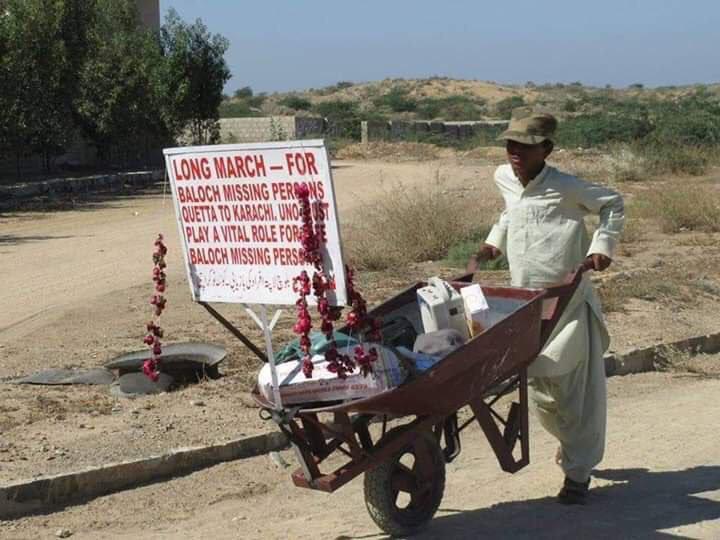The once-famous 11-year-old boy carrying a single-wheel trolley during the historic Long March to find his missing father is now a 16-year-old young man – an age which makes him almost eligible to go missing himself. And he did. On Sunday.
Ali Haider –the remarkably poised boy usually wearing an intense look and a flat cap in the photographs captured during the Long March – was picked up by security forces on June 16, 2019 from Gwadar, Balochistan’s so-called port city of future.
He went missing before he could manage to find his missing father, Muhammed Ramzan, who was picked up in 2010. Ramzan was travelling on a passenger bus to Gwadar along with a seven-year old Ali Haider and other family members when their vehicle was stopped at the Zero Point in Uthal. Frontier Corps soldiers stormed into the bus, identified Ramazan, beat him to a pulp, dragged him outside, bundled him into a military vehicle and sped away. This all happened in front of his terrified young son who cried and begged the soldiers to spare his father.
Ali Haider told this story about his old man to a news channel in 2014 to explain his participation in the Long March during which he covered over 2,000 kilometers from Quetta to Islamabad.
“Aren’t you afraid of dark nights on lonely roads,” journalist Hamid Mir asked him during the televised interview after the marchers reached Islamabad.
“I’m not here to be afraid. I’ve come here to find my (missing) father,” responded an assured Ali Haider.
The march was taken out by the families of missing persons, under the aegis of the Voice for the Missing Baloch Persons (VMBP), to put pressure on authorities to release their loved ones. It featured, among others, an old man called Mama Qadeer protesting for his previously missing and then dead son; a young woman called Farzana Majeed looking for her brother; and a young boy called Ali Haider.
The stubborn old man is currently sitting in front of the Quetta Press Club, still protesting for his dead son and constantly whining about threats he regularly receives from the security forces. The young woman was forced to flee the country and is now a refugee in the United States — her brother still being missing. The young boy, now a young man, is himself missing since last Sunday after being picked up in a security forces’ raid on his house in Gwadar where Chinese men are supposedly building mega-projects to help the destitute Baloch become the richest people under the sun.
Ali Haider or his father should not have ever gone to the promised land of Gwadar if they were let live peacefully in their hometown of Mashkay, an area worst hit by a prolonged conflict between Baloch separatist militants and Pakistan’s security forces. It was when Ali Haider’s school was taken over by the military and turned into a make-shift camp that the family moved to the heavily-guarded city of Gwadar where he and his sisters were supposed to continue their schooling.
Things did not go as desired though. Ramazan was taken away when he was taking his family to Gwadar while Ali Haider and his sisters took leave from school to participate in the march, hoping the authorities would take pity on their young innocence and release their father.
Unfortunately, he failed to find his father and the Long March ended without result. The authorities refused to take any pressure from the marchers and instead accused the old man, the young woman and the young boy of receiving funds from the arch-rival India, which seems to be the cause of Pakistan’s all miseries with proponents of military even claiming that India’s RAW is forcibly disappearing people to give Pakistan a bad name.
Ali Haider eventually disappeared from the scene after the failure of the Long March. Other protesters dispersed too, and the limelight was pulled away from the decade-long protest.
The campaign regained its momentum in November 2018 when some women protesters were manhandled by the police as they tried to march towards the Chief Minister’s House in Quetta. A video of the crying women went viral on the social media and people with missing relatives swarmed in the Quetta Press Club to share their pain.
It was during this time when Ali Haider made a comeback.
He, now almost a young man wearing a wispy moustache, recorded a live video from outside the press club to urge other relatives of missing persons to join in.
“I would like to remind you that I participated in the Long March in 2013 for my father Mohammed Ramzan Baloch,” he began his video message. “My mother and sisters were in the march too. We participated in the march to tell the authorities about the issue of missing persons and that nothing was being done about them. We thought if we went to the capital (Islamabad) we would get some response. So, we went from here (Quetta) to Islamabad but we didn’t get any response from the government that we were expecting. Today, again, I am joining the VMBP’s (protest) camp and I am here along with several other family members of missing persons. I request all the family members of missing persons to join the camp,” he said. “I, Ali Haider Baloch, will be with you till my last breath.”
It was a serious mistake from his end. Anyone from Balochistan could tell that he had already reached the age when he could easily become a victim himself. Someone, perhaps the old man sitting alongside him at the press club, should have told him that he was no longer the innocent 11-year-old boy who could get away after committing such a heinous crime. It was the time he should have fled the country and sought refuge elsewhere. It was the time he joined the young woman in the United States.
Sajid Hussain (1981-2020) was a writer and senior journalist from Balochistan. He had a degree in Economics, International Relations and English Literature from Karachi University. He had the experience of working with Pakistani newspapers Daily Times and The News International. Sajid Hussain was also the founding editor of this online magazine.



